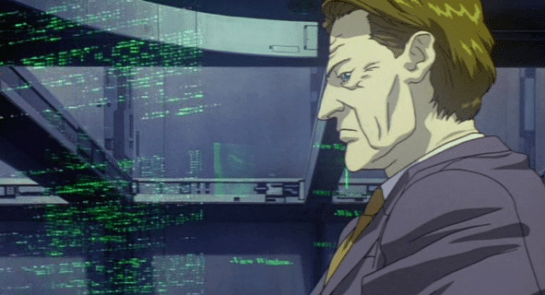
Many characters in Ghost in the Shell have a particular cybernetic augmentation that lets them use specially-designed keyboards for input.
Triple-hands
To control this input device, the user’s hands are replaced with cybernetic ones. Normally they look and behave like normal human hands. But when needed, the fingers of these each split into three separate mini-fingers, which can move independently. These 30 spidery fingerlets triple the number of digits at play, dancing across the keyboard at a blinding 24 positions per second.

The tera-keyboard
The keyboards for which these hands were built have eight rows. The five rows nearest the user have single symbols. (QWERTY English?) Three rows farthest from the user have keys labeled with individual words. Six other keys at the top right are unlabeled. Each key glows cyan when pressed and is flush with the board itself. In this sense it works more like a touch panel than a keyboard. The board has around 100 keys in total.

What’s nifty about the keyboard itself is not the number of keys. Modern keyboards have about that many. What’s nifty is that you can see these keyboards are massively chorded, with screen captures from the film showing nine keys being pressed at once.

Let’s compare. (And here I owe a great mathematical debt of thanks to Nate Clinton for his mastery of combinatorics.) The keyboard I’m typing this blog post on has 104 keys, and can handle five keys being pressed at once, i.e, a base key like “S” and up to four modifier keys: shift, control, option, and command. If you do the math, this allows for 1600 different keypresses. That’s quite a large range of momentary inputs.
But on the tera-keyboard you’re able to press nine keys at once, and more importantly, it looks like any key can be chorded with any other key. If we’re conservative in the interpretation and presume that 9 keys must be pressed at once—leaving 6 fingerlets free to move into position for the next bit of input—that still adds up to a possible 2,747,472,247,520 possible keypresses (≈2.7 trillion). That’s about nine orders of magnitude more than our measley 1600. At 24 keypresses per second, that’s a data rate of 6.5939334e+13 per second.

So, ok, yes, fast, but it only raises the question:
What exactly is being input?
It’s certainly more than just characters. Unicode‘s 110,000 characters is a fraction of a fraction of this amount of data, and it covers most of the world’s scripts.
Is it words? Steven Pinker in his book The Language Instinct cites sources estimating the number of words in an educated person’s vocabulary is around 60,000. This excludes proper names, numbers, foreign words, any scientific terms, and acronyms, so it’s pretty conservative. Even if we double it, we’re still around the number of characters in Unicode. So even if the keyboard had one keypress for every word the user could possibly know and be thinking at any particular moment, the typist would only be using a fragment of its capacity.

The only thing that nears this level of data on a human scale is the human brain. With a common estimate of 100 billion neurons, the keyboard could be expressing the state of it’s users brain, 24 times a second, distinguishing between 10 different states of each neuron.
This also bypasses one of the concerns of introducing an input mechanism like this that requires active manipulation: The human brain doesn’t have the mechanisms to manage 30 digits and 9-key-chording at this rate. To get it to where it could manage this kind of task would need fairly massive rewiring of the brain of the user. (And if you could do that, why bother with the computer?)
But if it’s a passive device, simply taking “pictures” of the brain and sharing those pictures with the computer, it doesn’t require that the human be reengineered, just re-equipped. It requires a very smart computer system able to cope with and respond to that kind of input, but we see that exact kind of artificial intelligence elsewhere in the film.
The “secret”
Because of the form factor of hands and keyboard, it looks like a manual input device. But looking at the data throughput, the evidence suggests that it’s actually a brain interface, meant to keep the computer up to date with whatever the user is thinking at that exact moment and responding appropriately. For all the futurism seen in this film, this is perhaps the most futuristic, and perhaps the most surprising.









